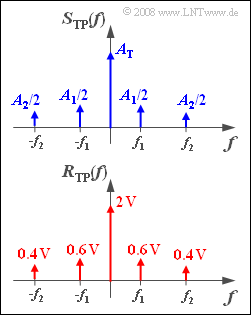Exercise 2.9: Symmetrical Distortions
The source signal made up of two components
- $$q(t) = A_1 \cdot \cos(2 \pi f_1 t ) + A_2 \cdot \cos(2 \pi f_2 t )$$
is amplitude modulated and transmitted through a linearly distorting transmission channel. The carrier frequency is $f_{\rm T}$ and the added DC component $A_{\rm T}$. Thus, a Double-sideband amplitude moduluation $\rm (DSB–AM)$ with carrier is present.
The upper graph shows the spectrum $S_{\rm TP}(f)$ of the equivalent low-pass signal in schematic form. This means that the lengths of the Dirac lines drawn do not correspond to the actual values of $A_{\rm T}$, $A_1/2$ and $A_2/2$ .
The spectral function $R(f)$ of the received signal was measured. In the lower graph we can observe the equivalent low-pass spectrum $R_{\rm TP}(f)$ calculated from this.
The channel frequency response is characterised with sufficient accuracy with a few auxiliary values:
- $$ H_{\rm K}(f = f_{\rm T}) = 0.5,$$
- $$H_{\rm K}(f = f_{\rm T} \pm f_1) = 0.4,$$
- $$ H_{\rm K}(f = f_{\rm T} \pm f_2) = 0.2 \hspace{0.05cm}.$$
Hints:
- This exercise belongs to the chapternbsp; Envelope Demodulation.
- Particular reference is made to the page Description using the equivalent low-pass signal.
Questions
Solution
- $${A_{\rm T}} \cdot 0.5 = 2 \,{\rm V}\hspace{0.3cm} \Rightarrow \hspace{0.3cm}A_{\rm T} \hspace{0.15cm}\underline {= 4 \,{\rm V}},$$
- $${A_{\rm 1}}/{2} \cdot 0.4 = 0.6\,{\rm V}\hspace{0.3cm} \Rightarrow \hspace{0.3cm}A_{\rm 1} \hspace{0.15cm}\underline {= 3 \,{\rm V}},$$
- $${A_{\rm 2}}/{2} \cdot 0.2 = 0.4\,{\rm V}\hspace{0.3cm} \Rightarrow \hspace{0.3cm}A_{\rm 2} \hspace{0.15cm}\underline {= 4 \,{\rm V}}\hspace{0.05cm}.$$
(2) Richtig ist der Lösungsvorschlag 3:
- Der Modulationsgrad ergibt sich zu $m = (A_1 + A_2)/A_T = 1.75$.
- Damit ergeben sich bei Verwendung eines Hüllkurvendemodulators starke nichtlineare Verzerrungen.
- Ein Klirrfaktor kann aber nicht angegeben werden, da das Quellensignal zwei Frequenzanteile beinhaltet.
(3) Richtig sind die Aussagen 1 und 2:
- Die Fourierrücktransformation von $R_{\rm TP}(f)$ führt zum Ergebnis:
- $$ r_{\rm TP}(t) = 2 \,{\rm V} + 1.2 \,{\rm V} \cdot \cos(2 \pi f_1 t ) + 0.8 \,{\rm V} \cdot \cos(2 \pi f_2 t )\hspace{0.05cm}.$$
- Diese Funktion ist stets reell und nicht–negativ.
- Damit gilt gleichzeitig $ϕ(t) = 0$. Dagegen ist $ϕ(t) = 180^\circ$ nicht möglich.
(4) Ein Vergleich der beiden Signale
- $$q(t) = 3 \,{\rm V} \cdot \cos(2 \pi f_1 t ) + 4 \,{\rm V} \cdot \cos(2 \pi f_2 t ),$$
- $$ v(t) = 0.4 \cdot 3 \,{\rm V} \cdot \cos(2 \pi f_1 t ) + 0.2 \cdot 4 \,{\rm V} \cdot \cos(2 \pi f_2 t )$$
- zeigt, dass nun lineare Verzerrungen – genauer gesagt Dämpfungsverzerrungen – auftreten ⇒ Lösungsvorschlag 2.
- Der Kanal $H_{\rm K}(f)$ hat hier den positiven Effekt, dass anstelle von irreversiblen nichtlinearen Verzerrungen nun lineare Verzerrungen entstehen, die durch ein nachgeschaltetes Filter eliminiert werden können.
- Dies ist darauf zurückzuführen, dass durch die stärkere Dämpfung des Quellensignals $q(t)$ im Vergleich zum Trägersignal $z(t)$ der Modulationsgrad von $m = 1.75$ auf $m = (0.4 · 3 \ \rm V + 0.2 · 4 \ \rm V)/(0.5 · 4 \ \rm V) = 1$ herabgesetzt wird.
